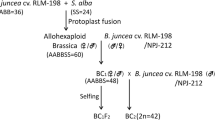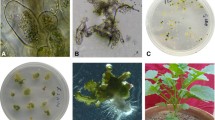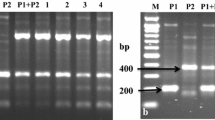Abstract
Camelina sativa, a wild relative of Brassica crops, is virtually immune to blackspot disease caused by Alternaria brassicicola. Intertribal somatic hybrids were produced between C. sativa and rapid-cycling Brassica oleracea as a step toward the transfer of resistance to this disease into Brassica vegetable crops. The plants recovered were confirmed as somatic hybrids by flow cytometry and RAPD analysis. All hybrids showed a morphology intermediate between the two parents. Rooted plants grew in soil up to 4–5 weeks, and some produced sterile flowers. Two of three hybrids tested showed a high level of resistance to A. brassicicola. Resistance was correlated with the induction of high levels of the phytoalexin camalexin 48 h after inoculation, as in the resistant Camelina fusion partner. In contrast, susceptible somatic hybrids produced much lower levels of camalexin.
Similar content being viewed by others
Author information
Authors and Affiliations
Additional information
Received: 2 April 1998 / Accepted: 14 July 1998
Rights and permissions
About this article
Cite this article
Sigareva, M., Earle, E. Camalexin induction in intertribal somatic hybrids between Camelina sativa and rapid-cycling Brassica oleracea. Theor Appl Genet 98, 164–170 (1999). https://doi.org/10.1007/s001220051053
Issue Date:
DOI: https://doi.org/10.1007/s001220051053




